JD Sports’ reported a 3.0% decline in like-for-like (LFL) sales over the second quarter, in line with market expectations. All regions posted declines in the period, except for Asia Pacific, up 0.3%. Trends in the US are improving, while Europe and the UK were impacted by tough comparatives due to the 2024 Euros.
Disciplined discounting and inventory management meant gross margins were only down 0.4 percentage points in a tough retail market.
Full-year underlying pre-tax profits are expected to be in line with market forecasts of around £885mn, weighted to the second half of the year. The group does not expect the direct impact of US tariffs to be material.
A new £100mn share buyback programme has been announced.
The shares rose 4.5% in early trading.
Our view
JD Sports' second-quarter performance was broadly as expected against the tough retail backdrop. Despite a small drop in sales, operational improvements mean that full-year profit guidance remains on track, and markets reacted positively on the day.
The US has been a major pain point in recent times due to a combination of a tough macroenvironment, product launch delays and heavy discounting by peers. JD’s been holding firmer on pricing than competitors, who have leaned into more promotional activity to help clear stock. While like-for-like sales are still in negative territory, there are early signs that trends across the pond are improving.
Closer to home, trading across Europe and the UK remains weak, especially in the latter. Year-on-year numbers have faced a tough comparative period, which got a foot up from the men's 2024 Euros. We remain cautious about the outlook for the UK, with recent changes to employer taxes and minimum wages bringing a handful of extra costs and challenges.
Acquisitions in the US and France have massively expanded the group’s footprint. The focus is now on converting them to the JD brand and leveraging the cost efficiencies this increased scale can bring. Early progress on this front looks promising, but there’s still a long road ahead.
The Hibbett acquisition means that the US is now JD Sports’ largest region by sales (Q2: 36%). Despite this, the direct impact of tariffs on its operations isn’t expected to be material. We’re keeping a close eye on the indirect impact of tariffs, which could ultimately weigh on consumers’ spending power. Given that JD sells discretionary items, if the economic outlook deteriorates, JD is likely to suffer more than some other areas of retail.
Group expectations for underlying pre-tax profits of around £885mn this year point to a decline. Looking past the near-term uncertainty, we’re pleased with the change of focus from expansion to squeezing the most out of its store footprint. That should strengthen the balance sheet and increase shareholder payouts, although there are no guarantees.
The challenges look priced into the current valuation, which sits well below the long-run average, offering both upside potential and some downside protection. We think this could be an attractive entry point for potential long-term investors. However, there’s plenty of challenges in the near term, including ever-changing tariffs and weak consumer sentiment, so be prepared for a bumpy ride.
Environmental, social and governance (ESG) risk
The retail industry is low/medium in terms of ESG risk but varies by subsector. Online retailers are the most exposed, as are companies based in the Asia-Pacific region. The growing demand for transparency and accountability means human rights and environmental risks within supply chains have become a key risk driver. The quality and safety of products as well as their impact on society and the environment are also important considerations.
According to Sustainalytics, JD Sports’ management of ESG risk is strong.
The group’s environmental policy is strong and executive remuneration is explicitly linked to sustainability performance targets. There is also an adequate whistleblower policy in place. However, ESG reporting and disclosures fall short of best practice.
JD Sports key facts
All ratios are sourced from LSEG Datastream, based on previous day’s closing values. Please remember yields are variable and not a reliable indicator of future income. Keep in mind key figures shouldn’t be looked at on their own – it’s important to understand the big picture.
This article is not advice or a recommendation to buy, sell or hold any investment.No view is given on the present or future value or price of any investment, and investors should form their own view on any proposed investment.This article has not been prepared in accordance with legal requirements designed to promote the independence of investment research and is considered a marketing communication.Non - independent research is not subject to FCA rules prohibiting dealing ahead of research, however HL has put controls in place(including dealing restrictions, physical and information barriers) to manage potential conflicts of interest presented by such dealing.Please see our full non - independent research disclosure for more information.


